P.J. Liesch, UW Entomology and R. Chris Williamson, formerly UW Entomology
Revised: 4/1/2022
Item number: XHT1063
The spongy moth, Lymantria dispar (formerly known as the “gypsy moth”) is native to parts of Europe, Asia, and North Africa. It was inadvertently introduced to North America in New England in 1869 and has since spread westward. Over time, the spongy moth has become one of the most important insect pests of forest and shade trees in the eastern U.S. The larva (caterpillar) is the destructive life stage that feeds on foliage which can result in defoliation. Repeated defoliation can weaken trees, resulting in greater susceptibility to disease and other insect pests. Spongy moth caterpillars can also be a nuisance when they aggregate on the sides of buildings or produce large quantities of frass (droppings) that fall from trees onto lawns and patios. The hairy caterpillars can also cause skin irritation.

Plants Attacked and Damage: Spongy moth caterpillars have been reported to feed on hundreds of species of trees and shrubs. Preferred hosts include aspen, birch, crabapple, hawthorn, linden, mountain ash, oak, and willow. Some deciduous trees (e.g., dogwood, green & white ash, honey locust, silver & red maple, and tulip tree) and most evergreen trees are generally resistant. Blue spruce and white pine can occasionally be attacked. Feeding damage frequently results in severe and/or complete defoliation which can weaken trees over time. On rare occasions, trees can be killed outright. In most cases, trees recover and produce new leaves in July.
Life Cycle & Appearance: The spongy moth has four distinct life stages: egg, larva (caterpillar), pupa, and adult (moth). Adult females lay eggs in masses of 500-1000 eggs in August. Egg masses are beige with a velvety texture and spongy consistency (hence the common name of “spongy moth”). Egg masses can be attached to a variety of surfaces and can be well hidden. They and are often found on buildings, lawn furniture, mail boxes, rocks and trees. Spongy moths overwinter in the egg stage.
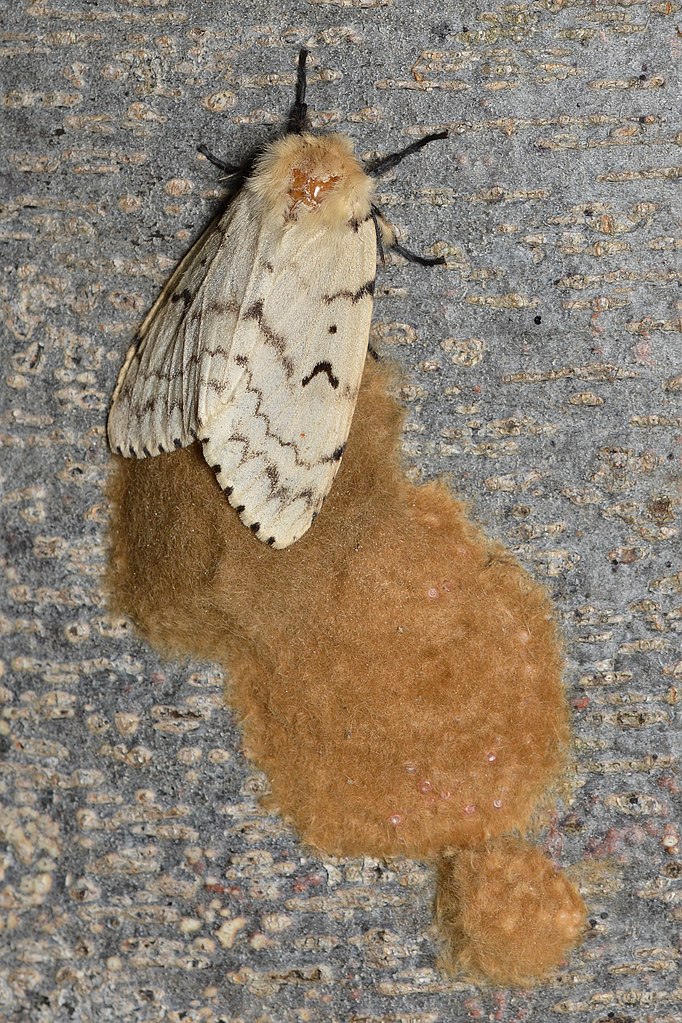
Small caterpillars emerge from the eggs in spring around the time that leaves are expanding (typically in May in Wisconsin). Newly hatched caterpillars climb up to foliage and begin feeding. If the first tree is not a suitable plant, caterpillars produce a silken thread and can be dispersed by the wind (“ballooning”). Once a suitable host plant has been found, they feed for five to six weeks. Spongy moth caterpillars have a “hairy” appearance and are initially a mottled grey color. They soon take on a characteristic appearance with pairs of blue and red bumps running down their backside; mature caterpillars reach lengths of 2+ inches. Spongy moth caterpillars pass through 5 or 6 substages known as instars. Early instars (one through three) feed during the day and cause little damage. Once larvae reach the fourth instar, they begin feeding at night and hide on rough bark or amongst leaf litter during the day. These later instars are larger and cause considerable damage. Approximately 90% of the feeding damage caused by larvae is done by the last two instars. After they have completed feeding, caterpillars pupate and adult moths emerge in July. Pupae are brownish, pod-like structures and are typically 1.5-2.5 inches long. The adults do not feed and only live long enough to mate and lay eggs. Adult moths are approximately 1-1.5 inches long. Female moths are slightly larger than males and are a pale color. Females cannot fly, but do release a chemical pheromone to attract males. The males are a dark brown color and can fly to females to mate.
Management: Management of the spongy moth depends on many factors, such as the number and size of affected trees, the overall area affected, and the life stage of the insect. Larger areas (i.e., forests and woodlots) cannot be effectively treated by individual landowners; consult a forester for guidance. In specific situations, aerial applications of a bacterial-based insecticide known as Bacillus thuringiensis kurstaki (“BTK”) may be used to help manage spongy moth populations. Mating disruption (i.e., the use of a synthetic version of the female’s sex pheromone) is occasionally used to limit the ability of adult spongy moths to mate in specific areas.
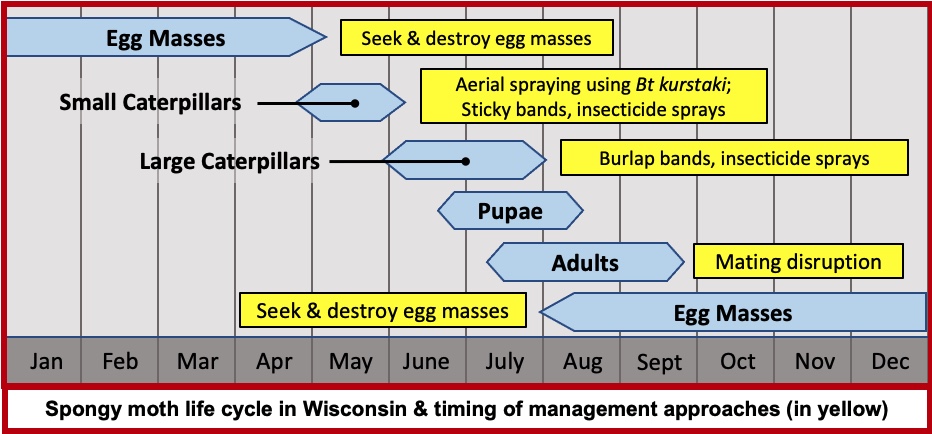
For small numbers of high-value plants, several management options exist. Destroying Eggs: Spongy moths spend ~75% of their life cycle as eggs. Locating and destroying the egg masses can help reduce populations in a small area. Egg masses can be scraped off surfaces with a putty knife and dropped into a container of soapy water for several days or bagged and discarded to kill them. Alternatively, egg masses can be treated with a dormant horticultural oil. Sticky Bands: Sticky bands can be used around tree trunks to capture and kill small caterpillars. The UW-Madison Division of Extension Spongy Moth website has full instructions for this method: bit.ly/3IZPdiS. Burlap Bands: Since larger caterpillars hide during the day, a band or skirt of burlap hung around the trunk of a tree with twine can offer a hiding spot. Burlap bands must be checked daily, and caterpillars can be knocked into a container of soapy water to kill them. Insecticide Sprays: For trees and shrubs that are short enough in height, insecticide sprays can be an option. Organic and reduced-impact sprays include insecticidal soaps, horticultural oils, pyrethrins, spinosad, and Bacillus thuringiensis kurstaki. These options work best against small caterpillars and the soaps, oils, and pyrethrins only work for a short period of time. Conventional insecticide sprays containing pyrethroid ingredients (e.g., bifenthrin, cyfluthrin, cyhalothrin, cypermethrin, deltamethrin, permethrin, etc.) are commonly sold at hardware stores & garden centers for controlling insect pests on landscape plants and typically protect treated foliage for 1-2 weeks at a time. Always read and follow all directions on the pesticide label. For large trees that cannot be effectively sprayed, consult a certified arborist about additional management options.
Biological Control: In areas where the spongy moth has been established for several years, natural enemies can help keep spongy moth populations in check. Natural enemies include insect parasites that attack eggs and caterpillars, predators such as birds, and insect-specific pathogens. A fungal pathogen called Entomophaga maimaiga has been introduced and helps curb spongy moth populations in many years. Spring precipitation helps encourage this fungus, while dry conditions limit its impacts.
For more information on spongy moth: See the UW-Madison Division of Extension spongy moth website fyi.extension.wisc.edu/spongymothinwisconsin, or contact your county Extension agent.
Download Article





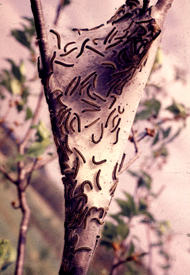 Webworms
Webworms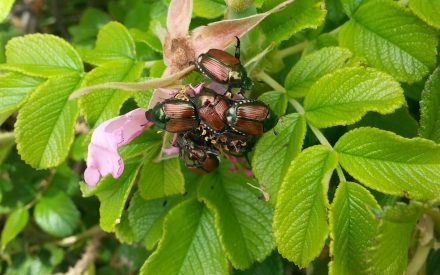 Japanese Beetle
Japanese Beetle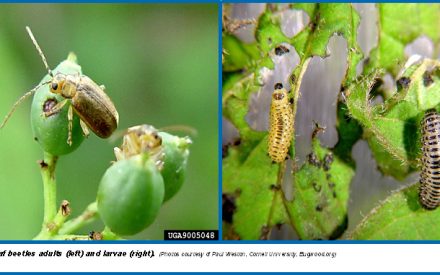 Viburnum Leaf Beetle
Viburnum Leaf Beetle Two Lined Chestnut Borer
Two Lined Chestnut Borer


